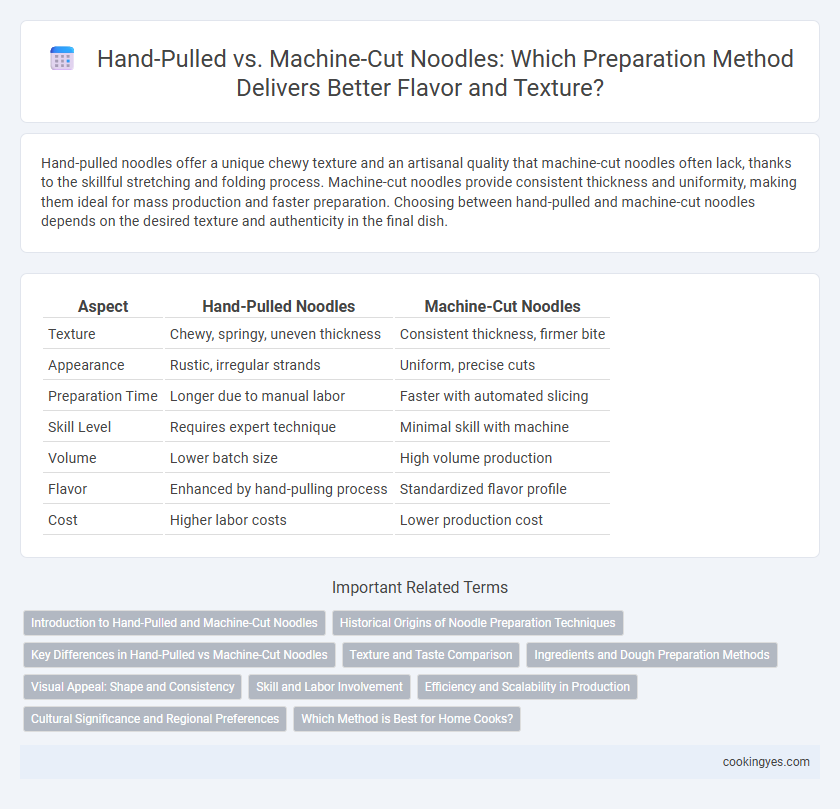Hand-pulled noodles offer a unique chewy texture and an artisanal quality that machine-cut noodles often lack, thanks to the skillful stretching and folding process. Machine-cut noodles provide consistent thickness and uniformity, making them ideal for mass production and faster preparation. Choosing between hand-pulled and machine-cut noodles depends on the desired texture and authenticity in the final dish.
Table of Comparison
| Aspect | Hand-Pulled Noodles | Machine-Cut Noodles |
|---|---|---|
| Texture | Chewy, springy, uneven thickness | Consistent thickness, firmer bite |
| Appearance | Rustic, irregular strands | Uniform, precise cuts |
| Preparation Time | Longer due to manual labor | Faster with automated slicing |
| Skill Level | Requires expert technique | Minimal skill with machine |
| Volume | Lower batch size | High volume production |
| Flavor | Enhanced by hand-pulling process | Standardized flavor profile |
| Cost | Higher labor costs | Lower production cost |
Introduction to Hand-Pulled and Machine-Cut Noodles
Hand-pulled noodles are crafted by stretching and folding dough repeatedly to create thin, elastic strands with a chewy texture, highlighting skilled craftsmanship and traditional techniques. Machine-cut noodles are produced by feeding dough through blades, allowing for consistent thickness and faster production, making them ideal for large-scale manufacturing. Both methods influence the texture and cooking time, with hand-pulled noodles offering a more artisanal experience and machine-cut noodles providing uniformity and efficiency.
Historical Origins of Noodle Preparation Techniques
Hand-pulled noodles trace back to the Han Dynasty in China, where skilled chefs stretched dough into thin strands using only their hands, emphasizing craftsmanship and tradition. Machine-cut noodles emerged during the industrial revolution, introducing mechanization that increased production speed and consistency without compromising texture. These divergent techniques reflect the evolution from artisanal methods to modern manufacturing in noodle preparation history.
Key Differences in Hand-Pulled vs Machine-Cut Noodles
Hand-pulled noodles are crafted by skilled chefs who stretch and fold dough repeatedly, enhancing gluten development for a chewy texture and uneven thickness that adds a unique mouthfeel. Machine-cut noodles, produced using automated cutters, offer uniform thickness and shape, enabling consistent cooking times and mass production efficiency. The choice between hand-pulled and machine-cut noodles impacts texture, taste authenticity, and preparation scalability in culinary applications.
Texture and Taste Comparison
Hand-pulled noodles offer a chewy, elastic texture with uneven, rustic strands that absorb sauce more effectively, enhancing flavor depth. Machine-cut noodles feature uniform thickness and a denser bite, delivering consistent texture but a less artisanal taste. Taste-wise, hand-pulled varieties tend to have a fresher, more complex flavor profile due to the manual stretching process affecting gluten structure.
Ingredients and Dough Preparation Methods
Hand-pulled noodles utilize high-gluten flour and a dough rested to develop elasticity, allowing skilled chefs to stretch and fold the dough repeatedly for a chewy texture. Machine-cut noodles often incorporate a slightly softer dough made from all-purpose flour combined with water and sometimes kansui, ensuring uniform thickness and faster production. The manual dough preparation emphasizes gluten development and precise water absorption, while machine-cut methods prioritize consistency and scalability in ingredient ratios.
Visual Appeal: Shape and Consistency
Hand-pulled noodles showcase irregular, slightly uneven strands that highlight artisanal craftsmanship, enhancing visual appeal through natural variation. Machine-cut noodles offer uniform thickness and perfectly straight edges, ensuring consistent presentation ideal for mass production. The choice between them impacts dish aesthetics, with hand-pulled favoring rustic charm and machine-cut emphasizing precision and regularity.
Skill and Labor Involvement
Hand-pulled noodles require significant skill and labor involvement, as artisans must expertly stretch and fold the dough to achieve the desired texture and thickness. This traditional method demands years of practice to master the precise tension and speed needed, resulting in uniquely elastic and chewy noodles. Machine-cut noodles reduce labor intensity and skill dependence by automating dough slicing, allowing for high-volume production with consistent shape and size but less artisanal texture.
Efficiency and Scalability in Production
Hand-pulled noodles offer artisanal texture and variability but limit efficiency due to manual labor constraints and slower production rates. Machine-cut noodles significantly enhance scalability by automating the dough stretching and slicing processes, allowing high-volume output with consistent thickness and shape. Industrial noodle manufacturers prioritize machine-cut methods to meet large demand while maintaining uniform product quality and reducing labor costs.
Cultural Significance and Regional Preferences
Hand-pulled noodles, rooted in Chinese culinary tradition, symbolize artisanal craftsmanship and regional identity, especially prominent in northern China where stretch techniques highlight texture and elasticity. Machine-cut noodles dominate in commercial settings across East Asia, offering efficiency and uniformity, yet they often lack the unique chewiness prized in hand-pulled variants. Regional preferences reflect cultural values, with hand-pulled noodles favored in areas celebrating traditional cooking methods and machine-cut noodles prevalent in urban environments prioritizing speed and consistency.
Which Method is Best for Home Cooks?
Hand-pulled noodles offer a unique texture and chewiness that enhances homemade dishes, providing a more authentic culinary experience. Machine-cut noodles, however, deliver consistent thickness and save preparation time, making them more practical for home cooks seeking efficiency. Choosing between hand-pulled and machine-cut depends on balancing texture preferences with convenience and skill level in home cooking.
Hand-pulled vs Machine-cut for noodle preparation Infographic

 cookingyes.com
cookingyes.com